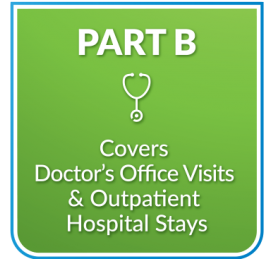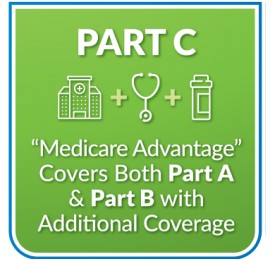Medicare Part C explained
Quick Links: Part C Covers – Part C Costs – Part C Enrollment – Part C Eligibility – Part C Premiums
Medicare Advantage, or also known as Medicare Part C, is a bundled Medicare plan offered by private insurance companies. These private companies work with Medicare and make sure they provide full benefits to all beneficiaries.
In a Medicare Advantage plan, private insurance companies work with Medicare to offer parts A and B medicare plans with some additional services called “Part C.” Part C plan also includes traditional Medicare plans that may not cover as vision care.
A recent survey proved that 34% of all people with Medicare also have are enrolled with Medicare Advantage plans such as HMO or PPO.
Suppose you are planning to join a Medicare Advantage Plan. In that case, Part C will cover all of your Part A and Part B. Medicare Advantage Plans may also offer extra coverage, including vision, hearing, dental, and wellness programs. Most plans also include Medicare prescription drug coverage.
Medicare regularly pays a fixed amount for your health expenses to the companies offering private Medicare advantage plans. These companies follow the rules set by Medicare that can change each year.
A variety of options to choose from when you opt for the Medicare C plan as:
- Special needs plans
- Medicare medical savings account plans
- Private fee-for-service plans
- Health maintenance organization plans
- Preferred provider organization plans
Medicare Part C covers:
A regular Medicare Part C covers everything that includes in Part A and Part B and added benefits. Medicare Part A. covers individual patient So, and Medicare Part C also covers the benefits of Part A, including:- Care in a hospital
- Skilled nursing facility care
- Home health care
- Doctor visits (primary care doctor and specialists)
- Laboratory tests and X-rays
- Ambulance services in an emergency
- Both inpatient and outpatient mental health services
- Durable medical equipment such as walkers and wheelchairs
- Preventative tests and vaccines, including flu shots
- Physical therapy
- Occupational therapy
- Speech and language pathology
Medicare Part C Costs
Various factors determine the Medicare Part C costs, including deductibles, copayments, premiums, and coinsurance. This amount ranges from $0 to hundreds of dollars for monthly premiums and yearly deductibles There are also various costs associated with Medicare Part C plans, including:- Monthly plan
- coinsurance
- Drug deductions
- Part B
- In-network deductions
- Co-pays
Medicare Part C Enrollment
Medicare C enrollment period (IEP) starts from 3 months before a person turns 65. During this period, a person can get enroll in:- Medicare Parts A and B
- Medicare Part C or Medicare Advantage
- Medicare Part D
Medicare Part C Eligibility
To enroll in Medicare part C a person needs to meet two eligibility conditions:- Currently enrolled in Original Medicare both Parts A and B
- Reside where the insurance provider offers the coverage that they require.
- This plan is also available during its application or enrollment period.








